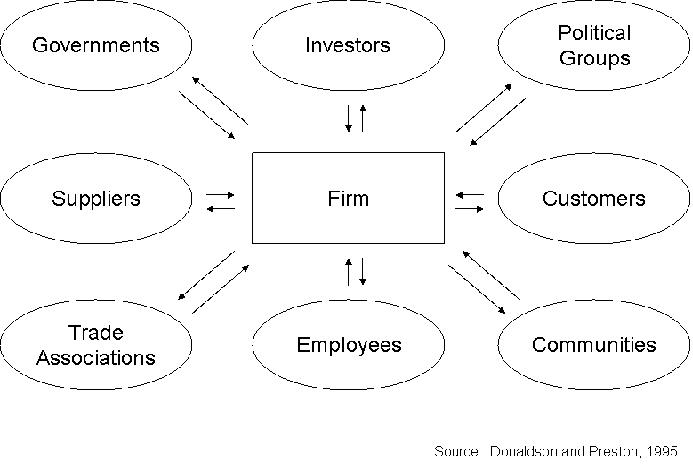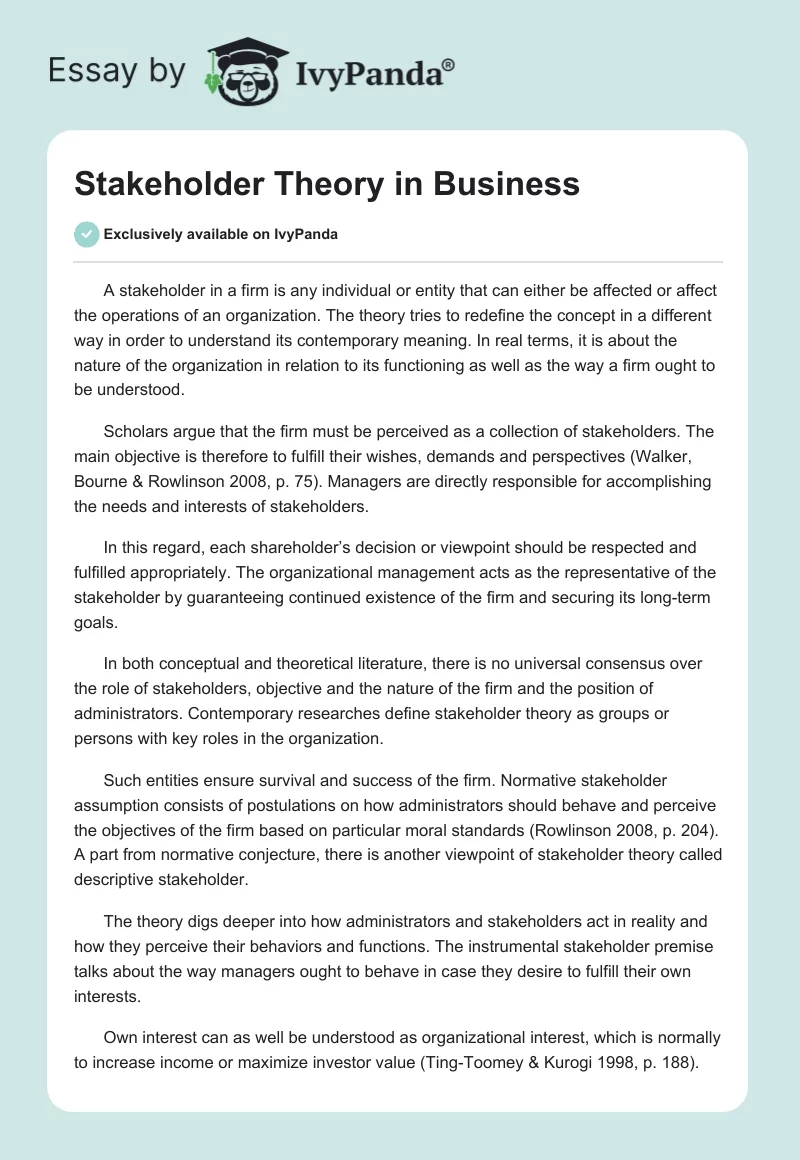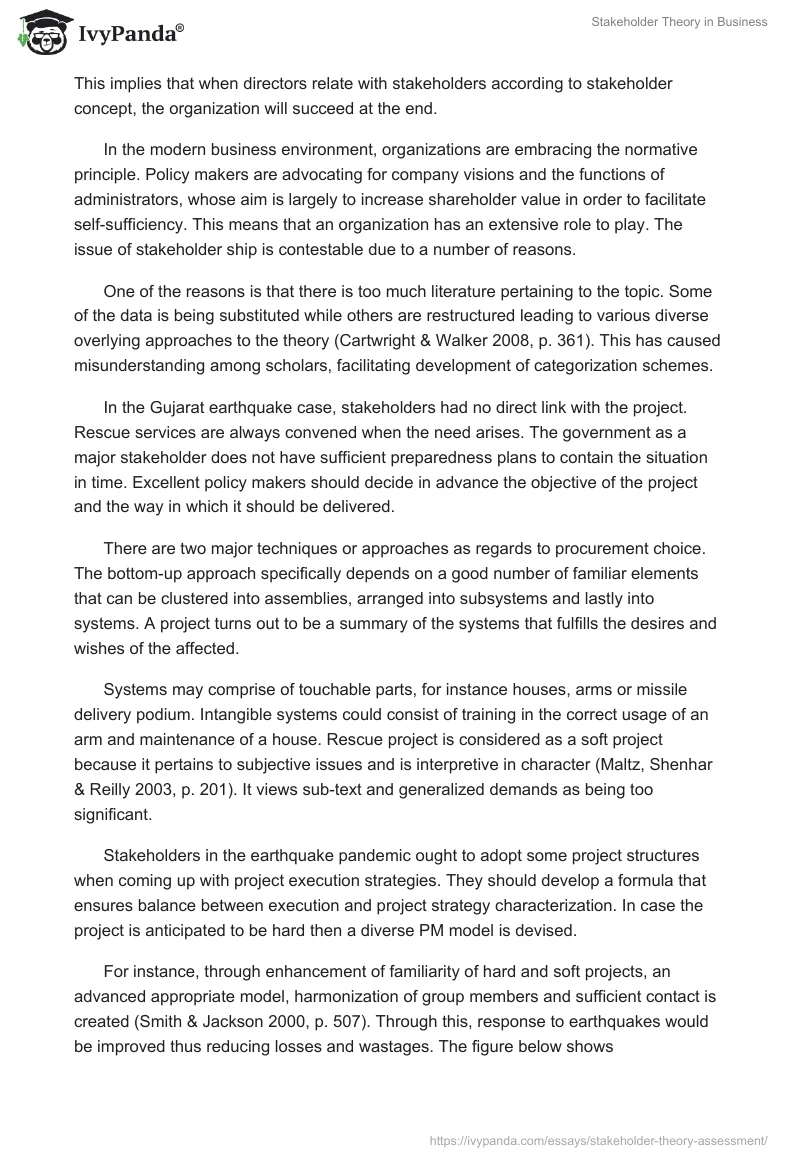A stakeholder in a firm is any individual or entity that can either be affected or affect the operations of an organization. The theory tries to redefine the concept in a different way in order to understand its contemporary meaning. In real terms, it is about the nature of the organization in relation to its functioning as well as the way a firm ought to be understood.
Scholars argue that the firm must be perceived as a collection of stakeholders. The main objective is therefore to fulfill their wishes, demands and perspectives (Walker, Bourne & Rowlinson 2008, p. 75). Managers are directly responsible for accomplishing the needs and interests of stakeholders.
In this regard, each shareholder’s decision or viewpoint should be respected and fulfilled appropriately. The organizational management acts as the representative of the stakeholder by guaranteeing continued existence of the firm and securing its long-term goals.
In both conceptual and theoretical literature, there is no universal consensus over the role of stakeholders, objective and the nature of the firm and the position of administrators. Contemporary researches define stakeholder theory as groups or persons with key roles in the organization.
Such entities ensure survival and success of the firm. Normative stakeholder assumption consists of postulations on how administrators should behave and perceive the objectives of the firm based on particular moral standards (Rowlinson 2008, p. 204). A part from normative conjecture, there is another viewpoint of stakeholder theory called descriptive stakeholder.
The theory digs deeper into how administrators and stakeholders act in reality and how they perceive their behaviors and functions. The instrumental stakeholder premise talks about the way managers ought to behave in case they desire to fulfill their own interests.
Own interest can as well be understood as organizational interest, which is normally to increase income or maximize investor value (Ting-Toomey & Kurogi 1998, p. 188). This implies that when directors relate with stakeholders according to stakeholder concept, the organization will succeed at the end.
In the modern business environment, organizations are embracing the normative principle. Policy makers are advocating for company visions and the functions of administrators, whose aim is largely to increase shareholder value in order to facilitate self-sufficiency. This means that an organization has an extensive role to play. The issue of stakeholder ship is contestable due to a number of reasons.
One of the reasons is that there is too much literature pertaining to the topic. Some of the data is being substituted while others are restructured leading to various diverse overlying approaches to the theory (Cartwright & Walker 2008, p. 361). This has caused misunderstanding among scholars, facilitating development of categorization schemes.
In the Gujarat earthquake case, stakeholders had no direct link with the project. Rescue services are always convened when the need arises. The government as a major stakeholder does not have sufficient preparedness plans to contain the situation in time. Excellent policy makers should decide in advance the objective of the project and the way in which it should be delivered.
There are two major techniques or approaches as regards to procurement choice. The bottom-up approach specifically depends on a good number of familiar elements that can be clustered into assemblies, arranged into subsystems and lastly into systems. A project turns out to be a summary of the systems that fulfills the desires and wishes of the affected.
Systems may comprise of touchable parts, for instance houses, arms or missile delivery podium. Intangible systems could consist of training in the correct usage of an arm and maintenance of a house. Rescue project is considered as a soft project because it pertains to subjective issues and is interpretive in character (Maltz, Shenhar & Reilly 2003, p. 201). It views sub-text and generalized demands as being too significant.
Stakeholders in the earthquake pandemic ought to adopt some project structures when coming up with project execution strategies. They should develop a formula that ensures balance between execution and project strategy characterization. In case the project is anticipated to be hard then a diverse PM model is devised.
For instance, through enhancement of familiarity of hard and soft projects, an advanced appropriate model, harmonization of group members and sufficient contact is created (Smith & Jackson 2000, p. 507). Through this, response to earthquakes would be improved thus reducing losses and wastages. The figure below shows interconnectedness between a firm and stakeholders (Donaldson & Preston 1995, p. 67).

Creation of a work breakdown structure (WBS) allows effective examination of a project, organization and management. Firstly, an exhaustive and extremely overt product breakdown structure (PBS) is developed. The structure describes a powerfully bottom-up approach. Then after, policy makers procuring a project ought to develop an assembly breakdown structure (ABS).
This explains the manner in which parts ought to be amassed. This integrates logistics and object accessibility, as well as other important production and manufacturing statistics and information.
The ABS aspect can be utilized to create a top-down model, which is a tree-like approach in project management. The project in this sense works as an interconnected sub-system (WBS) structured in terms of task and element (Kaplan & Norton 2004, p. 57).
Reported cases of negligence and highhandedness would not be witnessed in future if stakeholders adopt the above policies. Catastrophes occur suddenly hence only proper planning and procurement procedures can solve many problems facing stakeholders in the industry.
List of References
Cartwright, C & Walker, DHT 2008, ‘Case study – developing a centre of excellence (CoE)’, in Walker, D. H. T. & Rowlinson, S, Procurement Systems – A cross-industry project management perspective, Taylor & Francis, Abingdon, Oxen, pp. 358-377.
Donaldson, T & Preston, L 1995, ‘The stakeholder theory of the modern corporation: Concepts, evidence and implications’, Academy of Management Review, vol. 20 no. 1, 65-91.
Kaplan, RS & Norton, DP 2004, ‘Measuring the Strategic Readiness of Intangible Assets’, Harvard Business Review, vol. 82, no. 2, pp. 56-63.
Maltz, AC, Shenhar, A & Reilly, RR 2003, ‘Beyond the Balanced Scorecard: Refining the Search for Organizational Success Measures’, Long Range Planning, no. 36, pp. 187-204.
Smith, J & Jackson, N 2000, ‘Strategic needs analysis: its role in brief development’, Facilities, vol. 18, no. 13/14, pp. 502-512.
Ting-Toomey, S & Kurogi, A 1998, ‘Face work competence in intercultural conflict: An updated face-negotiation theory’, International Journal of Intercultural Relations, vol. 22, no. 2, pp. 187-225.
Walker, DHT & Nogeste, K 2008, ‘Performance measures and project procurement’, in Walker, D. H. T. & Rowlinson, S 2008, Procurement Systems – A cross-industry project management perspective, Taylor & Francis, Abingdon, Oxen, pp. 177-210.
Walker, DHT, Bourne, L & Rowlinson, S 2008, ‘Stakeholders and the supply chain’, in Walker, D. H. T. & Rowlinson, S, Procurement Systems – A cross-industry project management perspective, Taylor & Francis, Abingdon, Oxen, pp. 70-100.


